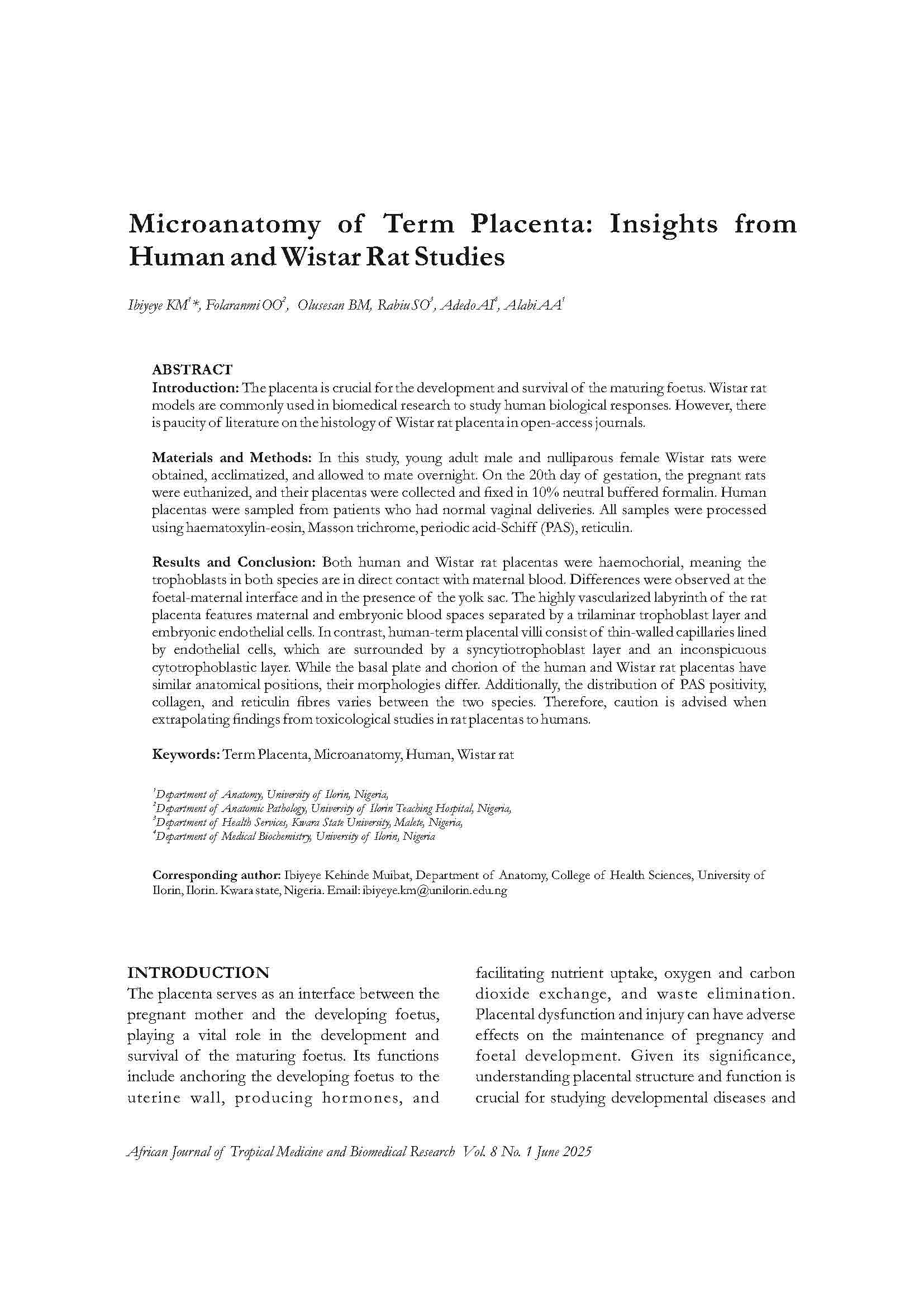Microanatomy of Term PlacentaInsights from Human and Wistar Rat Studies
Insights from Human and Wistar Rat Studies
DOI:
https://doi.org/10.4314/ajtmbr.v8i1.5Keywords:
Term placenta, microanatomy, human, Wistar ratAbstract
Introduction: The placenta is crucial for the development and survival of the maturing foetus. Wistar rat models are widely used in biomedical research to study human biological responses. However, there is limited open-access literature on the histology of the Wistar rat placenta.
Materials and Methods: Young adult male and nulliparous female Wistar rats were obtained, acclimatized, and allowed to mate overnight. On the 20th day of gestation, the pregnant rats were euthanized, and placentas were collected and fixed in 10% neutral buffered formalin. Human placentas were sampled from patients who had normal vaginal deliveries. All samples were processed using haematoxylin-eosin, Masson trichrome, periodic acid–Schiff (PAS), and reticulin stains.
Results and Conclusion: Both human and Wistar rat placentas were haemochorial, meaning the trophoblasts in both species are in direct contact with maternal blood. Differences were observed at the foetal–maternal interface and in the presence of the yolk sac. The highly vascularized labyrinth of the rat placenta features maternal and embryonic blood spaces separated by a trilaminar trophoblast layer and embryonic endothelial cells. In contrast, human-term placental villi consist of thin-walled capillaries lined by endothelial cells surrounded by a syncytiotrophoblast layer and an inconspicuous cytotrophoblastic layer. The basal plate and chorion of the human and Wistar rat placentas have similar anatomical positions, though their morphologies differ. The distribution of PAS positivity, collagen, and reticulin fibres varies between the two species. Caution is advised when extrapolating findings from rat toxicological studies to humans.
References
1. Furukawa S, Tsuji N, Sugiyama A. Morphology and physiology of rat placenta for toxicological evaluation. *J Toxicol Pathol.* 2019;32(1):1–17. doi:10.1293/tox.2018-0042.
2. Carter AM, Enders AC. Comparative aspects of trophoblast development and placentation. *Reprod Biol Endocrinol.* 2004;2:46. doi:10.1186/1477-7827-2-46.
3. Cross JC. How to make a placenta: mechanisms of trophoblast cell differentiation in mice—a review. *Placenta.* 2005;26(Suppl A):S3–S9. doi:10.1016/j.placenta.2005.01.015.
4. Elmore SA, Cochran RZ, Bolon B, Lubeck B, Mahler B, Sabio D, Ward JM. Histology atlas of the developing mouse placenta. *Toxicol Pathol.* 2022;50(1):60–117. doi:10.1177/01926233211042270.
5. Soares MJ, Chakraborty D, Karim Rumi MA, et al. Rat placentation: an experimental model for investigating the hemochorial maternal–fetal interface. *Placenta.* 2012;33(4):233–243. doi:10.1016/j.placenta.2011.11.026.
6. Cline JM, Dixon D, Ernerudh J, Faas MM, Göhner C, et al. The placenta in toxicology. Part III: Pathologic assessment of the placenta. *Toxicol Pathol.* 2014;42(2):339–344. doi:10.1177/0192623313482207.
7. Furukawa S, Kuroda Y, Sugiyama A. A comparison of the histological structure of the placenta in experimental animals. *J Toxicol Pathol.* 2014;27(1):11–18. doi:10.1293/tox.2013-0060.
8. Furukawa S, Hayashi S, Usuda K, Abe M, Hagio S, Ogawa I. Toxicological pathology in the rat placenta. *J Toxicol Pathol.* 2011;24(2):95–111. doi:10.1293/tox.24.95.
9. Charest PL, Vrolyk V, Herst P, Lessard M, Sloboda DM, Dalvai M, Haruna J, Bailey JL, Benoit-Biancamano MO. Histomorphologic analysis of the late-term rat fetus and placenta. *Toxicol Pathol.* 2018;46(2):158–168. doi:10.1177/0192623318755135.
10. Cross J. Trophoblast cell fate specification. In: Moffett A, Loke C, McLaren A (eds). *Biology and Pathology of Trophoblast: Functions and Evolution.* Cambridge University Press; 2006: 3–14.
11. Cross J, Werb Z, Fisher S. Implantation and the placenta: key pieces of the development puzzle. *Science.* 1994;266(5190):1508–1518.
12. Red-Horse K, Zhou Y, Genbacev O, Prakobphol A, Foulk R, McMaster M, Fisher SJ. Trophoblast differentiation during embryo implantation and formation of the maternal–fetal interface. *J Clin Invest.* 2004;114:744–754. doi:10.1172/JCI2299.
13. Szpirer C. Rat models of human diseases and related phenotypes: a systematic inventory of the causative genes. *J Biomed Sci.* 2020;27(1):84. doi:10.1186/s12929-020-00673-8.
14. Garvey W, Fathi A, Bigelow F, Carpenter B, Jimenez C. A combined elastic, fibrin, and collagen stain. *Stain Technol.* 1987;62(6):365–368. doi:10.3109/10520298709108026.
15. Krishna M. Role of special stains in diagnostic liver pathology. *Clin Liver Dis (Hoboken).* 2013;2(Suppl 1):S8–S10. doi:10.1002/cld.148.
16. Pernick N. Trichrome. *PathologyOutlines.com* website. Available from: [https://www.pathologyoutlines.com/topic/stainstrichrome.html](https://www.pathologyoutlines.com/topic/stainstrichrome.html). Accessed 7 Nov 2024.
17. Wang Y, Zhao S. *Vascular Biology of the Placenta.* San Rafael (CA): Morgan & Claypool Life Sciences; 2010. Chapter 3: Structure of the Placenta. Available from: [https://www.ncbi.nlm.nih.gov/books/NBK53256/](https://www.ncbi.nlm.nih.gov/books/NBK53256/).
18. Wells M, Bulmer JN. The human placental bed: histology, immunohistochemistry and pathology. *Histopathology.* 1988;13(5):483–498. doi:10.1111/j.1365-2559.1988.tb02073.x.
19. Singh K, Cohen MC. Anatomy & histology – placenta & umbilical cord. *PathologyOutlines.com* website. Available from: [https://www.pathologyoutlines.com/topic/placentanormalhistology.html](https://www.pathologyoutlines.com/topic/placentanormalhistology.html). Accessed 6 Nov 2024.
20. Fonseca BM, Correia-da-Silva G, Teixeira NA. The rat as an animal model for fetoplacental development: a reappraisal of the post-implantation period. *Reprod Biol.* 2012;12(2):97–118. doi:10.1016/S1642-431X(12)60080-1.
21. Espinoza J, Romero R, Mee Kim Y, Kusanovic JP, Hassan S, Erez O, Gotsch F, Than NG, Papp Z, Jai Kim C. Normal and abnormal transformation of the spiral arteries during pregnancy. *J Perinat Med.* 2006;34(6):447–458. doi:10.1515/JPM.2006.089.

Downloads
Published
Data Availability Statement
All data supporting this study are available from the corresponding author upon reasonable request.
Issue
Section
License
Copyright (c) 2025 African Journal of Tropical Medicine and Biomedical Research

This work is licensed under a Creative Commons Attribution-NonCommercial-ShareAlike 4.0 International License.
Key Terms:
- Attribution: You must give appropriate credit to the original creator.
- NonCommercial: You may not use the material for commercial purposes.
- ShareAlike: If you remix, transform, or build upon the material, you must distribute your contributions under the same license as the original.
- No additional restrictions: You may not apply legal terms or technological measures that legally restrict others from doing anything the license permits.
For full details, please review the Complete License Terms.



